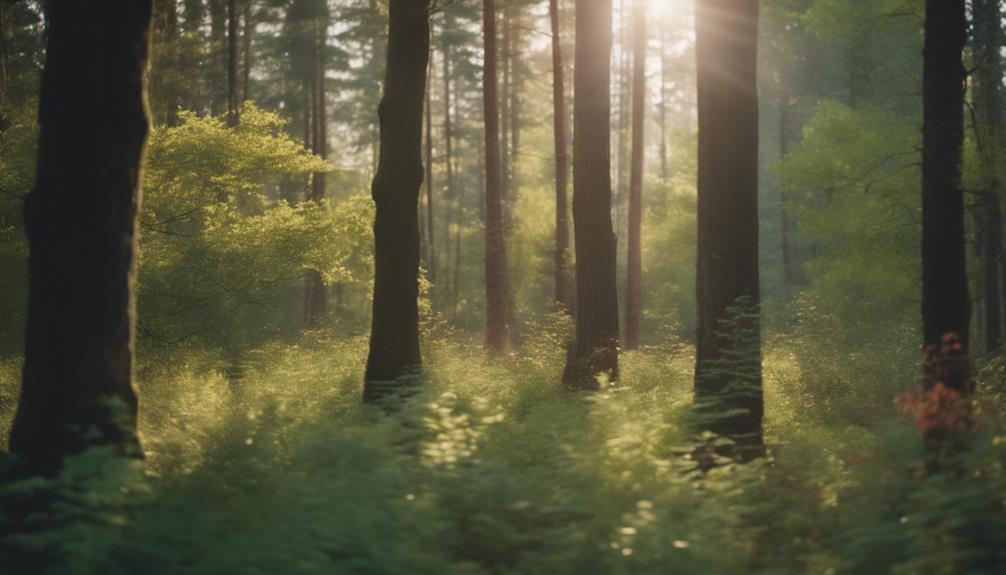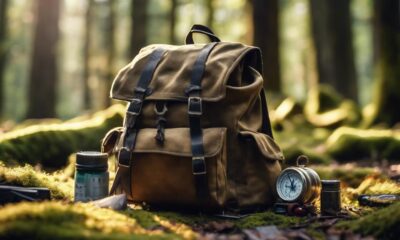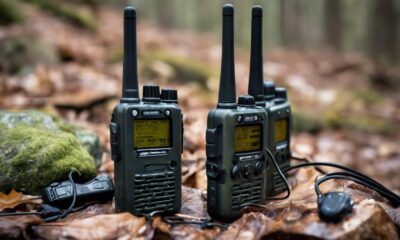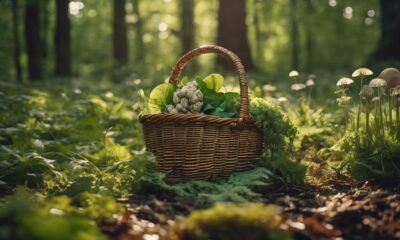Foraging Guides
Can You Forage in National Forests? Discover the Rules!
Investigate the rules and regulations governing foraging in national forests to avoid penalties and ensure sustainable practices.

You can forage in national forests, but understanding the rules and regulations is essential. The USDA Forest Service issues over 10,000 permits annually for responsible foraging practices. You'll need to obtain a permit, which type depends on your collection needs. Costs vary, with some permits being free or low-cost. Forest Service rules and restrictions aim to balance resource utilization with conservation efforts. To forage responsibly, you'll need to comprehend environmental protection and sustainability, regional variations, and private land vs public land foraging. By following the rules, you'll avoid penalties and contribute to preserving natural wonders – and there's more to discover about foraging in national forests.
Key Takeaways
- In the US, permits are often required to forage in National Forests, depending on the type and quantity of materials to be collected.
- The type of permit needed depends on the specific forest, region, and purpose of foraging, with options including Free Use Permits and Commercial Permits.
- Forest Service rules and regulations vary by region, and it's essential to check with local authorities for specific requirements and restrictions.
- Unauthorized foraging in National Forests can result in fines starting at $500, so it's crucial to obtain the necessary permits and follow sustainable foraging practices.
- National Forests offer vast areas for legal foraging, with some allowing up to 5 gallons of mushrooms without a permit, but regulations must be followed to preserve the ecosystem.
Understanding Permits and Regulations
Before you start foraging in National Forests, you'll need to understand the permits and regulations that govern this activity. Foraging in National Forests can be a rewarding experience, but it's crucial to do it responsibly and legally.
To guarantee the protection of resources and collectors, you'll need to obtain a permit from the USDA Forest Service District Offices. The type of permit you need will depend on your collection needs, and you may need approval from Forest Service personnel.
Types of Permits and Costs

As you prepare to forage in National Forests, you'll need to understand the types of permits available to you. Some forests may require that you obtain a free-use permit for personal foraging, while others may charge a fee depending on the quantity and types of materials collected. Be sure to check local regulations for specific guidelines, as rules can vary from one forest to another. Whether you’re foraging in Epping Forest or a National Forest, respecting the environment and adhering to permit requirements helps ensure sustainable use of natural resources.
There are two main types: Free Use Permits, which are typically granted for personal use, and Commercial Permits, which allow you to sell or exchange the materials you've collected.
You'll want to familiarize yourself with the specific requirements and costs associated with each permit type to make sure you're in compliance with regulations.
Free Use Permits
To guarantee the proper management and conservation of forest resources, it's crucial to check with the local authorities for specific requirements. Free use permits are important for foraging in national forests when the supply of forest products is abundant, but not for commercial purposes. This type of permit is perfect for personal use, such as botanical collection or research, as long as you're not planning to sell or exchange the harvested materials.
The good news is that these permits are usually free or low-cost, with a minimum charge of around $20. However, higher fees might apply to offset processing costs. The Forest Service personnel will determine if a permit is required based on your collection needs and resource protection.
Foraging regulations vary by forest and region, so it's crucial to check with the local authorities for specific requirements. Free use permits guarantee the proper management and conservation of forest resources. Remember, these permits are for personal use only, so if you're planning to sell or trade your harvested materials, you'll need to explore other permit options.
Always follow the rules and regulations to ensure the sustainability of our national forests.
Commercial Permits
When you plan to commercially harvest forest products, you'll need to secure a commercial permit, which varies in type and cost based on the scale and needs of your operation. This permit authorizes the removal of forest products for commercial purposes, but may have restrictions on selling or exchanging harvested materials.
Here are some key things to know about commercial permits:
- Minimum charges for small commercial permits can start at $20, with higher fees possible to cover processing costs for larger-scale operations.
- Special protection needs and high-value products may require different types of commercial permits with specific stipulations.
- Forest Service units provide detailed specifications for commercial permits, including designated collection areas, restrictions on rare plant species, seasonal limitations, and emphasis on safety practices during collection activities.
- You'll need to check with the local Forest Service unit for specific requirements and regulations, as these can vary depending on the location and type of foraging for wild products.
Forest Service Rules and Restrictions

Before embarking on a foraging expedition in National Forests, it's crucial to understand the Forest Service's rules and restrictions.
Familiarizing yourself with when permits are required, what forest products can be removed, and if commercial use is allowed in the area you're visiting will ensure a responsible and enjoyable foraging experience while also protecting these natural resources.
Permit Requirements
Before venturing out to forage in a National Forest, it's essential to understand that permits are often required, and obtaining one is typically the first step in ensuring a safe and sustainable collection process. This is especially important to note when foraging in national parks, as permit requirements can vary greatly.
When applying for a permit, you'll need to visit a USDA Forest Service District Office. The type of permit you need will depend on what you plan to collect, and may come with restrictions on what you can and can't remove from the forest.
Here are some key things to keep in mind when applying for a permit:
- Charges for permits can start at a minimum of $20, with higher fees to cover processing costs for larger permits.
- Forest Service personnel determine the need for permits to protect both the resource and the collector.
- Special protection needs may require different permit types, with varying costs and stipulations across Forests and Regions.
- Permit types vary based on collection needs and may include restrictions on removal of certain forest products.
Forest Product Removal
You'll need to understand the rules and restrictions governing forest product removal in National Forests, as these regulations can impact the sustainability of your foraging endeavors.
When it comes to collecting forest products like mushrooms, you may need a permit, which Forest Service personnel will determine based on your collection needs. The type and quantity of forest products you can remove are restricted, so it's vital to know what's allowed.
Permits may be required for forest product removal, and the specific guidelines, costs, and stipulations vary by Forest and Region. It's important to check with the local Forest Service office to understand the rules for the specific area you plan to forage in. They can provide you with the necessary information on permits, restrictions, and guidelines for sustainable forest product removal.
Commercial Use Restrictions
If you plan to use National Forest resources for commercial gain, be prepared to obtain the necessary permits and comply with Forest Service rules and restrictions, as unauthorized commercial activities can result in severe penalties.
The Forest Service has implemented commercial use restrictions to guarantee sustainable resource utilization and conservation. To operate commercially in National Forests, you'll need to secure permits, which are granted based on sustainability and resource protection considerations.
Here are some key points to keep in mind:
- Commercial use of resources without a permit is prohibited and can result in fines and legal actions.
- Permits are granted based on sustainability and resource protection considerations.
- Forest Service rules aim to balance resource utilization with conservation efforts.
- Compliance with Forest Service regulations is essential for sustainable commercial operations in National Forests.
Environmental Protection and Sustainability

How do your foraging practices in National Forests impact the delicate balance of the ecosystem and the environment as a whole? As you venture into these protected areas, it's crucial to contemplate the consequences of your actions.
By following foraging rules and adopting sustainable harvesting practices, you play a crucial role in maintaining ecosystem balance and biodiversity. Your responsible foraging practices contribute to the preservation of natural resources for future generations, ensuring a healthy environment and promoting sustainability.
When you adhere to foraging regulations in National Forests, you're supporting the long-term health of the ecosystem. This means being mindful of the plants you harvest, taking only what you need, and avoiding over-harvesting. By doing so, you're helping to preserve the natural beauty of these areas for years to come.
Regional Variations and Exceptions

Regional variations in foraging rules across National Forests mean you'll need to research the specific regulations in place for the forest you plan to visit. This is important to make sure you're engaging in legal foraging activities. You can't assume that what's allowed in one forest is permitted in another.
Before you head out, check with the local forest office or website to understand the specific rules and exceptions for that forest. Some forests may allow limited foraging without a permit, while others may require permits for mushroom foraging. You might be surprised to find that exceptions can be granted based on individual forest management plans.
Here are some key variations to take into account:
- Some forests have designated areas for foraging, while others allow it throughout the forest.
- Permits may be required for commercial foraging, but not for personal use.
- Certain species may be protected or have specific regulations around their harvest.
- Forests may have different rules for mushroom foraging versus other types of foraging.
Private Land Vs Public Land Foraging

You'll need to take into account a different set of rules when foraging on private land versus public land, as the regulations and permissions required can vary greatly depending on the type of land you're on. When it comes to private land, you'll typically need to obtain permission from the landowner or logging company before you start foraging.
On the other hand, public lands like National Forests have specific regulations in place, often allowing for mushroom picking with certain limits. National Parks typically prohibit foraging, except for specific areas. Public lands outside National Forests may have varying regulations, so it's important to research and understand the local rules. City/County/State Forests also have regulations that can differ, so it's crucial to do your research.
Remember to research and understand the regulations for the specific land you're on. National Forests offer vast areas for legal mushroom picking, with some allowing up to 5 gallons without a permit. Always prioritize proper research and contacting governing bodies to make sure you're foraging legally and responsibly.
Obtaining a Collection Permit

To obtain a collection permit for foraging in National Forests, head to the USDA Forest Service District Office, where personnel will guide you through the application process. You'll need to determine which type of permit is right for you, as they vary based on your collection needs. Forest Service personnel will assess whether a permit is necessary to safeguard the resources and collectors.
Here are some key things to keep in mind when applying for a collection permit:
- The type of permit you need will depend on the specific forest and region you're in
- Permits come with varying costs, stipulations, and durations
- Forest Products Free-Use Permits are available for personal use, but have restrictions on selling or exchanging harvested materials
- You'll need to provide information about your collection plans and methods to promote sustainable harvesting practices
Consequences of Unauthorized Foraging

If you're caught foraging in National Forests without a permit, you're likely to face some stiff penalties. Unauthorized foraging in these protected areas can result in fines starting at $500 – a hefty price to pay for some wild mushrooms or berries. Remember, harvesting plants or mushrooms without permission on public lands is illegal, and National Forests have regulations in place to protect their resources from unauthorized foraging.
Violating foraging rules in National Forests can lead to legal consequences that'll make you wish you'd taken the time to obtain a permit. It's essential to understand that these regulations are in place for a reason – to preserve the delicate balance of these ecosystems. By foraging without a permit, you're not only breaking the law, but you're also putting the very existence of these natural wonders at risk.
Don't take the risk; get informed, get a permit, and forage responsibly. The consequences of unauthorized foraging in National Forests are simply not worth it.
Responsible Foraging Practices

By embracing responsible foraging practices, you can guarantee that National Forests remain a treasure trove of natural wonders for generations to come. As you venture into these pristine areas, it's crucial to prioritize sustainability and environmental stewardship. This means adhering to specific guidelines and regulations to secure the long-term health of these ecosystems.
Here are some essential tips to keep in mind:
- Obtain permits where necessary to forage in National Forests
- Respect quantity limits to prevent over-foraging and promote sustainability
- Leave no trace, taking all waste and debris with you when you leave
- Educate yourself on specific rules and regulations for each National Forest you visit
Frequently Asked Questions
Are You Allowed to Forage in the New Forest?
You're wondering if you can forage in the New Forest? Yes, you're allowed to forage for fruits, nuts, and mushrooms for personal use, but be sure to follow the Forestry Commission's guidelines to avoid damaging the environment. However, it’s important to be mindful of what and how much you collect, ensuring that you’re not depleting natural resources. Collect only small amounts for personal use and avoid protected or rare species. If you’re foraging in other areas like Epping Forest, make sure to familiarize yourself with the specific foraging guidelines in Epping Forest, as regulations can vary from place to place.
What States Is Foraging Legal In?
As you venture into the wild, the American landscape unfolds like a treasure map, revealing secrets of the forest floor; in states like Texas, you'll find foraging is legal, with opportunities awaiting in U.S. National Forests.
What Is the Foraging Rule?
You're wondering what the Foraging Rule is – it's a regulation that governs mushroom picking in some U.S. National Forests, specifying quantity limits and permit requirements for commercial activities to conserve resources and promote public enjoyment.
Can You Harvest Plants in National Parks?
Imagine stumbling upon a rare wildflower in a National Park, but think twice before picking it – as a responsible visitor, you're not allowed to harvest plants in these protected areas, and violating rules can lead to fines.
Conclusion
So, you've made it through the rules and regulations of foraging in national forests. Congratulations! You're now equipped to forage like a pro, without getting fined or damaging the environment.
But, let's be real, most people won't bother reading the fine print. They'll just forage away, thinking they're above the law. Don't be that person.
Remember, responsible foraging is key to preserving our forests for future generations. So, go ahead, grab your basket, and forage on – responsibly, of course!
Foraging Guides
Wild Edibles Identification Apps Review
Wild edibles identification apps unlock nature’s culinary treasures, but which one will guide you most effectively on your foraging journey? Discover the best options inside!

Wild edibles identification apps are like treasure maps, guiding you to delicious plants in nature! For beginners, Wild Edibles Lite is easy to use and has lots of recipes. PictureThis is super accurate and user-friendly, while the Edible and Medicinal Plants app is a little tricky to navigate. Foraging Flashcard Lite is fun for memorizing plant names but doesn't give much info. Remember, it's important to forage responsibly and know your local rules! With the right app, you'll feel more confident exploring nature's bounty, and there's so much more to discover about these helpful tools!
Key Takeaways
- Wild Edibles Lite is beginner-friendly, covering 20 plants, with the full version offering over 200 plants and recipes for more advanced foragers.
- PictureThis provides high identification accuracy (90-95%) and user-friendly features, making it a reliable choice for plant exploration.
- The Edible and Medicinal Plants app has a complex interface that may complicate plant identification, requiring cross-referencing for accuracy.
- Responsible foraging practices, including sustainable harvesting and understanding local regulations, are emphasized across all apps to enhance safety and biodiversity.
- Community engagement and user feedback are vital for continuous improvement and app updates, fostering a supportive environment for foragers.
Overview of Wild Edibles Apps

When you're diving into the world of foraging, wild edibles apps can be a game changer in helping you identify and learn about various plants. These apps are like having a knowledgeable friend with you as you explore nature!
For instance, Wild Edibles Lite shares details on 20 wild plants, and if you're really curious, the full version teaches about over 200 plants, complete with yummy recipes.
If you travel a lot, the Edible and Medicinal Plants app could be your best buddy. It covers 110 plants and organizes them into five types of information, perfect for those who want to be prepared anywhere.
Another fun tool is the Foraging Flashcard Lite, which helps you memorize plant names in a super fun way, making learning exciting!
Safety is key when foraging, and the Wild Edibles app helps with that too, showing you poisonous look-alikes.
With all these options, you can feel confident and safe while discovering the amazing world of edible plants! So grab your app, head outside, and start your adventure with wild plants today!
Key Features to Consider

Choosing the right wild edibles app can greatly enhance your foraging experience. First, look for apps that give you lots of information about different plants. For example, Wild Edibles Lite has details on over 200 plants, which is super helpful! Additionally, understanding local regulations and foraging ethics can enrich your experience and ensure sustainable practices. Mammography guidelines are not only essential for breast cancer screening but can also serve as a reminder of the importance of thorough research in any field. It's also beneficial to recognize that many wild edibles can provide important nutrients, contributing to a nutritional balance in your diet. Moreover, being knowledgeable about diversification in your foraging approach can lead to a more varied and enjoyable experience.
You'll also want apps that include fun features like recipes for each plant, making it easy to enjoy your finds.
Another important feature is offline functionality. If you're exploring remote areas, the Wild Plant Survival Guide app lets you access information even without internet. You don't want to miss out on identifying a delicious plant just because you're out of range!
A user-friendly interface is also key. Apps like Seek let you quickly snap a picture of a plant, making identification simple and fast. This can be particularly useful when identifying mushrooms, where distinguishing between edible and toxic varieties is crucial for safety.
Plus, you should check the accuracy of the plant identification. PictureThis boasts an impressive accuracy rate of 90-95%, ensuring you can forage safely. Additionally, consider apps that provide information on integrated pest management to help you understand the ecological impact of foraging.
With these key features, you'll be well on your way to discovering and enjoying the wonderful world of wild edibles! Happy foraging!
Strengths and Weaknesses of Apps

When you explore wild edibles apps, you'll find some really cool strengths and a few tricky weaknesses.
For example, apps like Wild Edibles Lite give you tons of plant info, which is perfect for beginners, while others might make it hard to identify plants without extra searching. Additionally, understanding the role of apiculturists can enhance your foraging experience by providing insights into the importance of pollinators in ecosystems. Many of these apps also emphasize sustainable harvesting practices, ensuring that foragers contribute positively to local ecosystems. Moreover, being aware of essential survival skills can greatly improve your foraging techniques and overall safety in the wild. The use of foraging baskets can also enhance your collection process, making it easier to transport your edible finds.
It's important to think about how easy the app is to use and how accurately it helps you recognize your new green friends! Additionally, having access to survival gear can greatly enhance your confidence and safety when foraging in the wild.
Comprehensive Plant Information
Understanding the strengths and weaknesses of wild edibles identification apps is essential for anyone interested in foraging. Wild Edibles Lite excels with its extensive data on over 200 plants in the full version, making it a fantastic resource for beginners looking for detailed guidance. Imagination plays a vital role in enhancing creative solutions for identifying and utilizing plants effectively, which can elevate your foraging skills. Additionally, many of these plants, such as turmeric, offer anti-inflammatory properties that can be beneficial for health. Certain herbal alternatives can also provide additional benefits to your health and skin. Incorporating omega-3 sources like chia seeds into your diet can further enhance your overall well-being.
You'll love how it offers thorough information, including recipes for each plant, which is a unique feature. Additionally, incorporating foraging tips for rabbits can enhance your overall foraging experience, promoting better health and engagement with the environment.
On the flip side, the Edible and Medicinal Plants app has 110 plants but struggles with local plant ID. You might find yourself needing to cross-reference information, which can be a bit tricky. Technical issues, like accessibility problems with its PDF format, can also make using this app less enjoyable.
Meanwhile, Foraging Flashcard Lite is great for recognizing common wild edibles, but it doesn't provide extensive written information. This means you might miss out on some important details you'd want to know.
User Interface Quality
A strong user interface can make or break your experience with wild edibles identification apps. Wild Edibles Lite stands out with its intuitive layout and organized categories, making it easy for beginners to navigate and find detailed plant information. However, some apps can be tricky. Edible and Medicinal Plants has a more complex interface that might confuse you, requiring lots of cross-referencing to identify local plants. Furthermore, just as advanced filtration systems can enhance the performance of vacuums, a well-designed app can significantly improve your foraging experience. Inadequate maintenance of an app's user interface can lead to decreased user satisfaction, similar to how poor installation practices can result in operational problems for heat pumps. Regular user feedback can also play a vital role in improving app interfaces and ensuring they meet user needs. Additionally, apps that incorporate preventive measures for usability issues often see better user retention and satisfaction.
On the flip side, Foraging Flashcard Lite offers a simple design, but it only helps you memorize plant names without giving you detailed descriptions. Regular updates to app interfaces can enhance usability, similar to how vacuum cleaner performance metrics can significantly impact cleaning efficiency.
Check out the table below to see how these apps stack up:
| App Name | User Interface Quality | Privacy Practices |
|---|---|---|
| Wild Edibles Lite | Very user-friendly | Good privacy practices |
| Edible and Medicinal Plants | Complex and confusing | Moderate privacy practices |
| Foraging Flashcard Lite | Simple but lacking info | Good privacy practices |
| PictureThis | Easy with a great camera | Moderate privacy practices |
| Seek by iNaturalist | Easy to use, limited foraging | Minimal data collection
Identification Accuracy Challenges
Identifying wild edibles can be a tricky endeavor due to varying levels of accuracy among different apps. You might find that some apps shine with their features, while others stumble a bit when it comes to identification accuracy challenges. Here are a few things to keep in mind:
- Wild Edibles Lite is great for beginners, offering lots of plant info and categories, especially for those in temperate climates. Additionally, users can benefit from improving circulation by incorporating certain wild edibles that support overall health. Many wild edibles, like cotton candy grapes, provide unique flavors while being lower in calories compared to traditional sweets. Furthermore, using natural materials in the development of educational resources can enhance the learning experience related to foraging. Moreover, understanding pediatric sleep specialists can help parents feel more rested, allowing them to focus on foraging activities.
- The Edible and Medicinal Plants app has been criticized for making it hard to identify local plants, leading to lots of cross-referencing, which can be frustrating.
- Foraging Flashcard Lite helps you recognize names, but it doesn't provide enough detailed information for deeper understanding.
While apps like PictureThis have impressive accuracy rates of around 90-95%, others struggle with handling data and identifying certain plants reliably. This can leave you feeling confused or even disappointed. Additionally, understanding the importance of filter maintenance can enhance your overall experience with various apps by providing context on environmental factors that influence plant growth.
User Experiences and Feedback

Let's talk about what users think about the Wild Edibles apps! Many people are excited about finding tasty plants, but some have faced issues with getting the right info, which can be pretty frustrating. To ensure a safe foraging experience, users should consider integrating fire safety protocols into their outdoor adventures. They've shared ideas like adding leaf checks to help everyone enjoy a better experience while exploring nature! Additionally, users appreciate the importance of user feedback in improving app functionality and accuracy, which can greatly enhance their foraging adventures. Understanding nutritional needs can also help users make informed decisions about which wild edibles to forage. Incorporating knowledge of cardiovascular fitness can further enhance the overall health benefits from foraging activities. For those who wish to deepen their connection with nature, practicing visualization techniques can allow users to better align with their foraging aspirations.
User Sentiments and Insights
User feedback on wild edibles identification apps reveals a diverse range of experiences. Many users truly enjoy exploring nature with these tools, especially when they find a free app that helps with plant identification.
For instance, Seek by iNaturalist is loved for its simplicity and usefulness, making it perfect for casual plant explorers.
Here are some common sentiments users share:
- Accuracy Matters: Users rave about PictureThis because it's reliable, boasting a high accuracy rate of 90-95%.
- Beginner-Friendly: Wild Edibles Lite gets lots of love for its easy-to-understand info and tasty recipes, making it great for beginners.
- Room for Improvement: While the Wild Plant Survival Guide has a solid rating, some users wish it included more common edible plants. Additionally, understanding the principles of safe foraging practices can enhance the experience of identifying and gathering wild edibles.
Common Concerns and Suggestions
Many users have raised concerns about the accuracy of plant identification in certain apps, which can lead to frustration and even requests for refunds. For example, the app developed by Jorge Gregorio Martin Bello only has a 3.0 out of 5 rating, showing that not everyone's happy with it.
On the other hand, the Wild Plant Survival Guide app shines with a 4.6 out of 5 score, thanks to its great visuals and organization. Still, some users wish for better plant categorization and more common edible plants included. Additionally, including user feedback can help developers improve the app's accuracy and functionality. In particular, many seniors are embracing technology as a way to engage in playful communication, which can include using these apps for foraging. Incorporating native plants into the app can enhance the identification experience by connecting users to their local ecosystems. Furthermore, utilizing educational toys that promote exploration can foster a deeper understanding of the natural world.
You might also find it helpful to know that many users are asking for extra features. For instance, leaf checks could really boost the plant identification process.
The Seek app is popular for its friendly design and quick identification, but it isn't integrated into iPhone iOS, which confuses some folks. Community chats often highlight the need for better tools, especially for identifying edible mushrooms. Furthermore, users have noted that early socialization in different environments can enhance identification skills and reduce mistakes when foraging.
Recommended Foraging Apps

Here are some recommended foraging apps that you and your family members can use:
- iNaturalist: This free app lets you log your observations and connect with experienced foragers. It's perfect for learning and engaging with a community of fellow plant lovers, enhancing your emotional well-being as you share discoveries. Additionally, engaging with foraging communities can help you stay informed about regulatory compliance in your area. Using such platforms can also deepen your knowledge of natural ingredients commonly found in foraged plants.
- Wild Edibles: This app categorizes plants based on different criteria and includes important safety information about poisonous look-alikes. It's a must-have for safe foraging!
- PictureThis: With over 10,000 plants in its library, this app boasts high accuracy in plant identification. In-app purchases give you access to even more features.
Foraging can also provide access to nutrient-rich plants, enhancing your overall health and well-being. These apps make foraging fun and educational for everyone. Whether you're a beginner or a seasoned forager, you'll find something useful.
Responsible Foraging Practices

Responsible foraging practices are all about respecting nature and ensuring that plant populations thrive. When you go foraging, it's crucial to follow sustainable foraging practices. This means you should only pick what you need and leave enough plants behind to grow again. Overpicking can hurt our precious plants! Additionally, understanding herb spawn locations can help you forage responsibly without damaging local ecosystems. Engaging in responsible foraging can also support emotional regulation, as spending time in nature has been shown to promote mental well-being. Furthermore, practicing long-term financial planning for foraging can help you invest in proper tools and resources to enhance your skills.
Here's a quick guide to help you remember responsible foraging tips:
| Tip | Description |
|---|---|
| Leave No Trace | Don't disturb the area; pick carefully! |
| Take Only What You Need | Only harvest what you can use. |
| Know the Laws | Familiarize yourself with local foraging rules. |
| Identify Plants | Learn to tell apart edible and poisonous plants. |
| Use Community Resources | Join groups or read guides to enhance your skills! |
Additionally, practicing responsible foraging can help preserve plant populations that are essential for maintaining biodiversity in our ecosystems.
Final Thoughts on App Usage

Using foraging apps can greatly enhance your experience in the wild, especially if you're just starting out. These apps are fantastic tools that help you identify plants, learn about local flora, and even connect with other foragers. Just remember to be mindful of your privacy when using them.
Here are a few tips to keep in mind:
- Choose apps that are user-friendly and have positive feedback for accuracy, like Seek or PictureThis.
- Engage with community forums to share knowledge and find safe foraging practices.
- Be cautious about sharing personal information, especially if you're in a survival situation.
With over 200 plants to discover, foraging apps like Wild Edibles Lite can make learning fun and interactive. They help you feel more confident as you explore.
Plus, developers are working on features to boost social interaction, so you can share your finds with friends!
Just remember that while these apps are helpful, they should complement your outdoor adventures, not replace them.
Frequently Asked Questions
Is There an App to Identify Edible Wild Plants?
Yes, there are some awesome apps to help you identify edible wild plants!
You can try Wild Edibles Lite, which tells you about over 200 plants and even has recipes.
PictureThis is another cool app, boasting a 90-95% accuracy rate in identifying plants.
If you want instant feedback, Seek by iNaturalist lets you snap a picture, helping you learn on the go!
Just remember, always double-check before munching on anything!
How Do You Identify Wild Edibles?
To identify wild edibles, start by looking closely at the plant's features. Check the leaf shape, flower color, and where it grows.
You can use apps that help you match what you see! Don't forget to ask experienced foragers in community groups for tips—they love sharing!
Always double-check your findings with different sources to be safe. Remember, exploring nature can be fun, but knowing what's safe to eat is super important!
Which Plant Identifier App Is Most Accurate?
When you want to find the most accurate plant identifier app, you've got some great choices!
PictureThis claims a fantastic accuracy rate of 90-95%, which is impressive!
Seek by iNaturalist is also fun to use; it shows an accuracy meter that gets better as you zoom in.
If you've got a newer iPhone, the Visual Look Up tool is handy too!
Just remember, these apps aren't perfect for identifying edible mushrooms. Happy exploring!
Do Plant Scanning Apps Really Work?
Imagine you're a plant detective, ready to solve nature's mysteries!
Plant scanning apps can be really helpful for identifying green wonders around you. They snap a picture, and voilà! You get a name.
Most apps boast high accuracy, but don't forget, they mightn't always recognize tricky plants, like edible mushrooms.
Conclusion
So, when you're out exploring nature, these wild edibles apps can be your trusty sidekicks! They help you spot tasty treats while keeping you safe. Just remember, finding a juicy berry is exciting, but knowing how to pick it responsibly is even better. With the right app in hand, you'll enjoy adventures filled with delicious discoveries. So grab your gear, head outside, and let the fun of foraging begin! Happy hunting!
Foraging Guides
Foraging Tools and Equipment Guide
Unlock the essentials of foraging with the right tools and equipment; discover what you need to enhance your outdoor adventure!

Foraging is an exciting adventure that lets you explore nature, and having the right tools really makes a difference! You'll want a sturdy carrier bag to hold your wild treasures and a hori-hori knife for digging or transplanting plants. Heavy-duty chopping knives and berry rakes are fantastic for tougher jobs and gentle berry picking, respectively. Don't forget a reliable map or GPS for safe navigation! Dressing in waterproof footwear and insect protection gear keeps you comfy and safe while you forage. Stick around, and you'll discover even more about the important gear and sustainable practices that make foraging fun and responsible!
Key Takeaways
- Essential foraging tools include a hori hori knife, heavy-duty chopping knife, and mushroom knives for various harvesting tasks.
- A sturdy carrier bag and foraging basket are crucial for collecting and transporting wild edibles and mushrooms safely.
- Quality foraging bags, waterproof footwear, and functional apparel enhance comfort and protection during outdoor foraging adventures.
- Reliable maps or GPS devices are essential for navigation in unfamiliar foraging locations to ensure safety and success.
- Sustainable harvesting techniques and responsible foraging principles help maintain ecosystem balance and protect local flora and fauna.
Essential Foraging Tools

When you head out foraging, having the right tools can make all the difference in your experience.
You'll want to pack a sturdy carrier bag to hold all your treasures, like wild edibles and tasty mushrooms. A good knife is essential for cutting and preparing your finds. The Hori Hori knife is fantastic for digging up roots and transplanting plants. Proper foraging can also complement your emergency preparedness strategies, ensuring you have fresh food sources during challenging times. Additionally, ensuring proper airflow around the unit of your carrying bag can help prevent any moisture buildup that might spoil your finds. It's important to remember that foraging can also support biodiversity by promoting the growth of native plants when done sustainably.
Caffeine from coffee can enhance your exercise performance, which may be useful if foraging requires stamina. For tougher jobs, a heavy-duty chopping knife or a digging fork can help you dig deep without harming nearby plants. If you plan to collect tree barks or branches, a pruning saw is your best friend. It makes cutting small branches easy and efficient. Additionally, using proper foraging tools helps ensure sustainable harvesting practices, which are crucial for maintaining healthy ecosystems.
Foraging Gear and Apparel

What gear and apparel do you need for a successful foraging adventure? First, grab some quality foraging bags! Mesh bags and cooler backpacks are great because they let air flow and keep your mushrooms and herbs fresh.
You'll also want waterproof footwear, like sturdy boots, to keep your feet dry and comfy on all kinds of trails. Consider choosing footwear that is designed for various terrains to enhance stability and comfort while foraging. Additionally, investing in inflation-protected annuities can help secure your financial future while you enjoy your outdoor adventures.
Next, don't forget functional apparel! Merino wool layers help regulate your temperature, while durable outdoor pants with knee pads protect you from prickly plants. It's also wise to wear clothing made from weather-resistant materials to help shield you from unexpected rain or wind.
If you're foraging in areas with pesky bugs, insect protection gear like bug spray and head nets will keep those mosquitoes away.
For long trips, having hydration systems such as water bladders or collapsible bottles is super important. Staying hydrated helps you stay energized while you search for wild foods.
And remember, a good mushroom knife and field guides are essential to help you identify what's safe to eat. Additionally, consider using eco-friendly materials for your gear to ensure safety and sustainability during your outdoor adventures.
With the right gear and apparel, you'll be ready for an exciting foraging adventure! Enjoy the great outdoors and all the delicious treasures it has to offer!
Knives and Harvesting Equipment

Foraging requires the right tools, and having a few essential knives and harvesting equipment can make all the difference. When you're out exploring, a good knife can be your best friend! Here's a handy table to help you choose the right tools for your foraging adventures:
| Tool | Purpose |
|---|---|
| Hori Hori | Digging roots and transplanting |
| Mushroom knives | Cutting and cleaning delicate fungi caps |
| Opinel knives | Sharp and lightweight for various cutting tasks |
| Pruning saws | Cutting small branches and gathering barks |
You might want to carry one of these tools: multi-tools that combine a knife and saw are perfect for surprises! If you're just starting out, a pocket knife works wonders too. Don't forget, you can also use scissors for smaller tasks. Each tool has its own special job, helping you gather nature's goodies with ease. Additionally, using tools that are well-maintained can significantly enhance operational efficiency during your foraging adventures. Foraging also encourages self-reliance as you learn to identify and utilize local resources, fostering your emotional resilience in the process. Interestingly, the process of foraging can mirror the divorce proceedings in some states, where patience and the right tools are essential for navigating complex situations. Moreover, understanding the importance of basket size and shape can further improve your foraging experience. So pack your bag, grab your knives, and get ready for a fun foraging day! Happy hunting!
Navigation and Safety Resources

Having the right tools is only part of a successful foraging adventure; knowing how to navigate and stay safe is just as important. First, grab a reliable map or a GPS device! These will help you find the best foraging spots and keep you on track in unfamiliar places. Additionally, utilizing AI automation can enhance your navigation efforts by providing data-driven insights on the best routes. It's also beneficial to be aware of essential oils for respiratory health that can help you breathe easier while exploring nature. Remember that understanding mining difficulty is crucial for optimizing your foraging routes, as it can impact how quickly you navigate through various terrains. Foraging in national parks can provide a rich variety of edible plants and mushrooms.
It's also great to practice your compass skills, which can be a fun challenge while exploring nature.
Don't forget a first aid kit! Accidents can happen, and it's smart to be ready for any minor scrapes or bumps you might encounter.
When foraging, it's super important to know about poisonous plants and mushrooms, so make sure to bring along some handy foraging books to help you identify safe options.
Staying hydrated is key to having energy during your outdoor adventures. Pack enough water to keep you refreshed.
As you venture into the wild, remember that safety comes first! With these navigation and safety resources, you're all set for a fun, successful foraging experience. Additionally, understanding how to create foraging toys for pets can enhance your outdoor adventures by providing enrichment opportunities for your animals.
Now, get out there and explore the wonders that nature has to offer!
Sustainable Harvesting Techniques

Sustainable harvesting techniques are essential for enjoying nature's bounty while protecting the environment. When you're out foraging for plants, remember to take only what you need. This way, you leave plenty behind for them to grow back and keep the ecosystem balanced. Individuals who practice mindful gathering often develop a deeper appreciation for the interconnectedness of nature and the importance of maintaining biodiversity. Many historic farms also emphasize sustainable farming practices, which can enhance your foraging experience by promoting ecological balance. Additionally, understanding the concept of biodiversity can guide your choices in what to harvest, ensuring that you contribute positively to local ecosystems.
Additionally, employing sustainable practices helps to ensure that foraging does not contribute to environmental degradation. For roots, grab tools like a hori hori knife or a digging fork. These help you dig without harming the surrounding soil or other plants.
When it comes to berry picking, be selective and gentle. Using berry rakes can make your job easier and help protect the plants. Always check local regulations, too! Knowing what you can and can't harvest keeps vulnerable plants safe and guarantees you're following the law.
Ethical foraging means respecting the environment. Avoid overharvesting and practice mindful gathering. This way, you can enjoy the wild treasures while keeping wildlife habitats safe. Additionally, understanding the importance of sustainable harvesting techniques can enhance your foraging experience and ensure the preservation of local ecosystems.
With the right tools and techniques, you can have fun harvesting wild goodies without causing harm. So, gear up, explore responsibly, and delight in the wonders of nature! Happy foraging!
Frequently Asked Questions
What Tools Do You Need for Foraging?
When you're ready to forage, you'll want a few helpful tools!
Grab some Felco pruners for snipping herbs and a Hori Hori knife for digging up roots. A sharp little knife will help you peel bark too!
Don't forget a sturdy basket for your goodies, and gloves to keep your hands safe.
With these tools in hand, you'll be ready for an exciting adventure in nature, discovering all sorts of tasty treasures!
What Is the Number One Rule of Foraging?
Think of foraging like a treasure hunt in nature!
The number one rule you've gotta remember is to positively identify any plant or mushroom before eating it. Just like a pirate wouldn't take a chance on a fake treasure, you shouldn't risk your health on look-alikes.
Always check, learn, and double-check. This way, you can enjoy your finds safely and have a fun adventure in the great outdoors!
Happy foraging!
How Do Beginners Do Forage?
To start foraging, you'll want to learn about the tasty plants growing around you.
Grab a field guide or check online resources to identify what's safe to eat. It's fun to join local foraging groups or workshops, where you can meet other beginners and learn from experts.
Don't forget to bring a breathable basket for your finds.
What Should You Avoid When Foraging?
When you're out foraging, it's super important to avoid a few things!
First, steer clear of areas treated with chemicals, like pesticides, since they can make plants unsafe to eat.
Don't pick plants from protected spots either, as it can harm nature and get you in trouble.
Also, always make sure you know what a plant is before you eat it!
Finally, remember to leave some plants behind to help them grow.
Happy foraging!
Conclusion
Now that you've got the scoop on foraging tools and gear, you're ready to explore the great outdoors! Think of foraging like a treasure hunt, where every plant and mushroom could lead you to something special. With the right tools and a bit of practice, you'll become a foraging pro in no time. So grab your gear, venture out, and enjoy the wonders of nature. Happy foraging, and may your adventures be as bright as a sunny day!
Foraging Guides
Wild Food Preservation Methods
Preserve your wild food with exciting methods that promise delicious meals year-round—discover the secrets to keeping your harvest fresh!

Preserving wild food is super fun and helps you enjoy yummy meals all year long! You can try different methods like dehydration, which removes moisture, or smoking, which adds flavor while keeping food fresh. Fermentation is another cool option that makes food tastier and healthier. It's important to pick the right technique based on what you're preserving and where you'll store it, like a cool, dry place. Always keep things clean and label your goodies with dates so you know when they were made. Ready to discover some tasty preservation tips and tricks? Let's go!
Key Takeaways
- Dehydration effectively removes moisture from wild foods, inhibiting bacteria and mold growth for long-term storage.
- Fermentation enhances flavor and nutritional value while creating an acidic environment that preserves wild foods.
- Vacuum sealing prevents oxidation and moisture exposure, making it ideal for preserving the freshness of wild edibles.
- Curing with salt can draw out moisture and enhance flavors in wild meats, extending their shelf life.
- Chia seed incorporation can enrich wild foods, improving flavor and longevity through its natural preservation properties.
Importance of Food Preservation

Food preservation plays an essential role in our daily lives, as it helps fend off spoilage and foodborne illnesses. When you preserve food, you protect it from rapid bacteria growth, especially in raw meat. This is vital because you want to stay healthy and enjoy your meals! In fact, understanding community property laws can help you make informed decisions about food-related assets during a divorce. Additionally, utilizing techniques rooted in sound healing science can enhance the preservation process by creating an optimal environment for food storage. Regularly consuming preserved foods can also help maintain a balanced diet and support health considerations. Furthermore, incorporating essential oils for food preservation can provide additional antimicrobial benefits that keep food safe and flavorful.
Effective preservation techniques, like curing and smoking, not only extend the shelf life of meat but also add delicious flavors that make your food even tastier.
Having knowledge of preservation methods is super important, especially for wilderness survival. If you're out camping and don't have a fridge, you'll want to guarantee you have a steady food supply to keep you energized and happy.
By using proper storage techniques, such as keeping food in airtight containers and maintaining cool temperatures, you can greatly reduce spoilage and waste. This helps promote food security, so you always have something nutritious to eat.
Mastering food preservation skills boosts your self-sufficiency and resilience. Plus, it gives you peace of mind knowing you can access familiar food sources during emergencies. Additionally, understanding hearth and floor protection requirements can help ensure safe food storage practices in your home.
Common Preservation Techniques

When it comes to preserving wild foods, several effective techniques can help you extend their shelf life and enhance their flavors.
One popular method is dehydration, which removes moisture from fruits, vegetables, and meats. This process inhibits the growth of bacteria and mold, making it perfect for long-term storage. Additionally, dehydrating foods can also help burn calories through physical activity, as preparing and storing food often involves movement. Using essential oils like tea tree oil during the cleaning process can further enhance food safety. Incorporating chia seeds into your diet can also provide added nutritional benefits during this preservation phase. Moreover, turmeric's anti-inflammatory properties can support overall health while enjoying preserved foods.
Curing is another fantastic technique, where you apply salt and spices to meat. This not only draws out moisture but also adds a delicious flavor while keeping your meat fresh for longer.
Fermentation is a fun way to preserve foods like sauerkraut and kimchi. Beneficial bacteria create an acidic environment, boosting flavor and nutrition!
Don't forget about smoking! This technique gives meats and fish a yummy taste while killing bacteria, extending their shelf life too.
Finally, vacuum sealing is a great method that removes air from packaging. By preventing oxidation and moisture exposure, it helps keep your food fresh.
Incorporating educational toys into your preservation practices can also enhance creativity and problem-solving skills in children, making food preservation a fun family activity.
Using these preservation techniques can make your wild foods last, ensuring food safety and tasty meals for everyone.
Advanced Preservation Methods

Building on common preservation techniques, advanced methods offer even more ways to store wild foods effectively. One fantastic option is confit preparation, where you salt and slowly cook meats like duck in their own fat. This method not only makes the meat tender but also helps it last longer! Additionally, gorse plants are known to provide essential nectar sources for bees, which can be beneficial when considering food sources for your own preservation efforts. Implementing energy-efficient technology in your food storage systems can further enhance the sustainability of your preservation practices.
Another great technique is rendering fat, which is essential for making pemmican. By purifying fat from meat, you can create a nutrient-rich snack that stores well for long periods. The high protein content in pollen from plants like gorse can also support bee health, making it important to consider which plants to incorporate into your wild food landscape. Additionally, incorporating seeds like chia seeds into your diet can provide essential nutrients that support overall health.
Fermentation is another exciting advanced preservation method. It uses good bacteria to create an acidic environment, keeping harmful microbes away while boosting flavor. Think of delicious sauerkraut or kimchi—yummy and packed with nutrients! This method is similar to how stingless bees create honey with unique flavor profiles through their own natural processes.
For those looking to preserve low-acid foods like meats and veggies, pressure canning is the way to go. This method uses high heat to kill bacteria in sealed jars, allowing you to enjoy your wild foods for months! Just as awareness of plant presence is essential for bee health, understanding your preservation methods can ensure the longevity of your wild foods.
Incorporating preservation methods such as chia seed jam can also enhance your wild food experience by offering unique flavors and extended shelf life.
With all these advanced preservation methods, you can enjoy your wild foods and keep them fresh and tasty for a long time.
Choosing the Right Technique

Selecting the right preservation technique is essential for maintaining the quality and safety of your wild foods. With so many options, it can feel overwhelming, but don't worry!
Here's a quick list to help you decide:
- Type of Meat: Some methods, like smoking and curing, work best for red meats, while freezing is great for poultry.
- Environmental Conditions: Check the temperature and humidity. Techniques like sun drying need clear skies and low moisture from food.
- Available Resources: If you don't have a fridge, salting or making confit might be a better choice for food storage and preservation.
- Storage Duration: Think about how long you want to keep your food. Dehydration can extend shelf life for months or even years, while freezing usually lasts up to one year.
Additionally, considering the foundational skills your food preservation methods can foster may influence your choice, as certain techniques encourage creativity and resourcefulness in food preparation.
Tips for Successful Preservation

Successfully preserving wild foods hinges on a few key practices that can make all the difference.
First, always verify that your equipment, like jars and containers, is thoroughly sterilized. This helps prevent contamination and spoilage of your delicious food! Regularly checking indoor air quality can also contribute to a healthier environment, ensuring your preservation efforts are not hindered by pollutants. Additionally, maintaining a clean workspace is crucial for avoiding cross-contamination and preserving food quality, which involves following food safety guidelines. Investing in an air purifier with HEPA filtration can also enhance the cleanliness of your workspace.
Next, use the right preserving methods for each type of food. For instance, canning works great for fruits and veggies, while dehydration is an effective method for meats. Additionally, pet therapy can enhance emotional well-being, which may help you stay focused and motivated during the preservation process.
When it comes to storage, keep an eye on temperature and humidity. A cool, dry place will help maintain their quality and extend the shelf life of your preserves. Remember that air purifiers can be beneficial in improving indoor air quality, which supports the preservation environment.
Don't forget to label everything with the date you preserved it! This way, you can enjoy the freshest food first and minimize waste. Additionally, staying informed about personal debt forgiveness bills can help you manage any financial challenges that may arise when investing in preservation equipment.
Frequently Asked Questions
How Do You Preserve Food in the Wild?
You can preserve food in the wild using a few fun techniques!
First, try drying fruits or herbs in the sun to keep them tasty and light.
Smoking meat adds a yummy flavor while also keeping it safe to eat.
You can also sprinkle salt on food to draw out moisture and help it last longer.
What Are the 5 Methods of Food Preservation?
When it comes to preserving food, you've got five exciting methods to choose from!
First, there's dehydration, where moisture escapes like a magic trick, keeping food fresh.
Then, canning seals in flavors, like a tasty treasure chest!
Fermentation brings out zingy flavors, while smoking adds a smoky twist.
Finally, salting works like a superhero, drawing out moisture and saving meats.
With these methods, your food stays delicious and safe for longer!
How to Preserve Food in the Forest?
When you're in the forest, preserving food can be a fun adventure! You can dry fruits and veggies in the sun, which makes them crunchy and sweet.
Try using salt on meat to keep it fresh and tasty. Smoking adds a delicious flavor while keeping the food safe.
Fermenting veggies in salty water is another cool way to preserve them. Finally, pickling in vinegar makes for yummy snacks that last longer!
Enjoy your tasty treats!
How Do You Keep Meat From Going Bad in the Wild?
Keeping meat from going bad in the wild is like playing a fun game of hide and seek with bacteria!
First, you've gotta clean and handle the meat right after you catch it, just like washing your hands before a snack.
Next, try salting it, which helps pull out moisture, or smoke it for extra flavor and safety.
If you have a freezer, that's a great way to keep it fresh for later adventures!
Conclusion
To sum up, preserving wild foods is a fun and rewarding adventure! Whether you’re drying herbs or making delicious jams, these methods help keep your tasty finds for longer. For example, imagine picking fresh berries on a sunny day, then turning them into sweet jelly that you can enjoy all winter! So go ahead, try out different techniques and share your yummy creations with friends and family. You’re bound to make some tasty memories along the way! Additionally, don’t forget to explore the world of wild edible flowers. From dandelions to violets, there are so many beautiful and flavorful blossoms to experiment with. They can add a unique and colorful twist to your culinary creations, and the process of preserving them can be just as enjoyable as the end result. So, get out there, discover the edible treasures of nature, and savor the satisfaction of preserving wild foods for all seasons.
-

 Vetted6 months ago
Vetted6 months ago15 Best Wilderness Survival Fiction Books to Fuel Your Adventurous Spirit
-

 Foraging Guides6 months ago
Foraging Guides6 months agoAre Forage Internships Worth It? Here's What You Need to Know!
-

 Coastal Foraging7 months ago
Coastal Foraging7 months agoHow to Dry Age a Fish? The Ultimate Guide for Seafood Lovers
-

 Vetted6 months ago
Vetted6 months ago15 Best Wilderness Survival Books Every Outdoor Enthusiast Must Read
-

 Coastal Foraging7 months ago
Coastal Foraging7 months ago15 Best GMRS Radios for Preppers: Stay Prepared and Connected in Any Situation
-

 Coastal Foraging7 months ago
Coastal Foraging7 months ago15 Best Baofeng Radios for Preppers – Stay Connected in Any Situation
-

 How to Forage7 months ago
How to Forage7 months agoVirginia’s Wild Harvest: Forage for Delicious Edibles!
-

 Vetted6 months ago
Vetted6 months ago6 Best Wilderness Survival Games for Ios to Test Your Skills in the Wild


























